Characterization of the Quality Factor Due to the Static Prestress in Classical Caputo and Caputo–Fabrizio Fractional Thermoelastic Silicon Microbeam
Abstract
:1. Introduction
2. Model Formulation
3. Descriptions of the Six Models
- , and represents the traditional Lord–Shulman model with one relaxation time [54].
- , represents the Lord–Shulman model based on the classical Caputo fractional definition (Lord–Shulman (C-C)).
- represents the Lord–Shulman model based on the Caputo–Fabrizio fractional definition (Lord–Shulman (F-C)).
- , represents the traditional Tzou dual-phase-lag (DPL) model.
- , represents the Tzou dual-phase-lag (DPL) model based on the classical Caputo fractional definition (Tzou (C-C)) [42].
- represents the Tzou dual-phase-lag (DPL) model based on the Caputo–Fabrizio fractional definition (Tzou (F-C)).
4. Numerical Results and Discussions
5. Conclusions
Author Contributions
Funding
Conflicts of Interest
References
- Duwel, A.; Candler, R.N.; Kenny, T.W.; Varghese, M. Engineering MEMS resonators with low thermoelastic damping. J. Microelectromech. Syst. 2006, 15, 1437–1445. [Google Scholar] [CrossRef]
- Guo, F.; Rogerson, G. Thermoelastic coupling effect on a micro-machined beam resonator. Mech. Res. Commun. 2003, 30, 513–518. [Google Scholar] [CrossRef]
- Harris, C.M.; Piersol, A.G. Harris’ Shock and Vibration Handbook; McGraw-Hill: New York, NY, USA, 2002; Volume 5. [Google Scholar]
- Koyama, T.; Bindel, D.S.; He, W.; Quévy, E.P.; Govindjee, S.; Demmel, J.W.; Howe, R.T. Simulation tools for damping in high frequency resonators. In Proceedings of the IEEE SENSORS, Irvine, CA, USA, 30 October–3 November 2005; p. 4. [Google Scholar]
- Zener, C. Internal friction in solids. I. Theory of internal friction in reeds. Phys. Rev. 1937, 52, 230. [Google Scholar] [CrossRef]
- Zener, C. Internal friction in solids II. General theory of thermoelastic internal friction. Phys. Rev. 1938, 53, 90. [Google Scholar] [CrossRef]
- Zener, C.; Otis, W.; Nuckolls, R. Internal friction in solids III. Experimental demonstration of thermoelastic internal friction. Phys. Rev. 1938, 53, 100. [Google Scholar] [CrossRef]
- Lifshitz, R.; Roukes, M.L. Thermoelastic damping in micro-and nanomechanical systems. Phys. Rev. B 2000, 61, 5600. [Google Scholar] [CrossRef] [Green Version]
- Sun, Y.; Fang, D.; Soh, A.K. Thermoelastic damping in micro-beam resonators. Int. J. Solids Struct. 2006, 43, 3213–3229. [Google Scholar] [CrossRef] [Green Version]
- Sharma, J.; Sharma, R. Damping in micro-scale generalized thermoelastic circular plate resonators. Ultrasonics 2011, 51, 352–358. [Google Scholar] [CrossRef]
- Tzou, D. On the thermal shock wave induced by a moving heat source. J. Heat Transf. 1989, 111, 232–238. [Google Scholar] [CrossRef]
- Tzou, D.; Puri, P. Macro-to microscale heat transfer: The lagging behavior. Appl. Mecha. Rev. 1997, 50, B82. [Google Scholar] [CrossRef]
- Xu, M.; Guo, J.; Wang, L.; Cheng, L. Thermal wave interference as the origin of the overshooting phenomenon in dual-phase-lagging heat conduction. Int. J. Therm. Sci. 2011, 50, 825–830. [Google Scholar] [CrossRef]
- Al-Huniti, N.S.; Al-Nimr, M. Thermoelastic behavior of a composite slab under a rapid dual-phase-lag heating. J. Therm. Stresses 2004, 27, 607–623. [Google Scholar] [CrossRef]
- Ho, J.-R.; Kuo, C.-P.; Jiaung, W.-S. Study of heat transfer in multilayered structure within the framework of dual-phase-lag heat conduction model using lattice Boltzmann method. Int. J. Heat Mass Transf. 2003, 46, 55–69. [Google Scholar] [CrossRef]
- Lee, Y.-M.; Tsai, T.-W. Ultra-fast pulse-laser heating on a two-layered semi-infinite material with interfacial contact conductance. Int. Commun. Heat Mass Transf. 2007, 34, 45–51. [Google Scholar] [CrossRef]
- Liu, K.-C. Numerical analysis of dual-phase-lag heat transfer in a layered cylinder with nonlinear interface boundary conditions. Comput. Phys. Commun. 2007, 177, 307–314. [Google Scholar] [CrossRef]
- Ramadan, K. Semi-analytical solutions for the dual phase lag heat conduction in multilayered media. Int. J. Therm. Sci. 2009, 48, 14–25. [Google Scholar] [CrossRef]
- Alghamdi, N. Dual-Phase-Lagging Thermoelastic Damping Vibration in Micro-Nano Scale Beam Resonators with Voids. Int. J. Multidiscip. Curr. Res. 2017, 5, 71–78. [Google Scholar]
- Alghamdi, N.A.; Youssef, H.M. Dual-phase-lagging thermoelastic damping in-extensional vibration of rotating nano-ring. Microsyst. Technol. 2017, 23, 4333–4343. [Google Scholar] [CrossRef]
- Guo, F.; Song, J.; Wang, G.; Zhou, Y. Analysis of thermoelastic dissipation in circular micro-plate resonators using the generalized thermoelasticity theory of dual-phase-lagging model. J. Sound Vib. 2014, 333, 2465–2474. [Google Scholar] [CrossRef]
- Guo, F.; Wang, G.; Rogerson, G. Analysis of thermoelastic damping in micro-and nanomechanical resonators based on dual-phase-lagging generalized thermoelasticity theory. Int. J. Eng. Sci. 2012, 60, 59–65. [Google Scholar] [CrossRef]
- Dai, H.; Zheng, Z.; Wang, W. A new fractional wavelet transform. Commun. Nonlinear Sci. Numer. Simul. 2017, 44, 19–36. [Google Scholar] [CrossRef]
- Zheng, Z.; Dai, H. A new fractional equivalent linearization method for nonlinear stochastic dynamic analysis. Nonlinear Dyn. 2018, 91, 1075–1084. [Google Scholar] [CrossRef]
- Dai, H.; Zheng, Z.; Ma, H. An explicit method for simulating non-Gaussian and non-stationary stochastic processes by Karhunen-Loève and polynomial chaos expansion. Mech. Syst. Signal Process. 2019, 115, 1–13. [Google Scholar] [CrossRef]
- Povstenko, Y. Fractional Thermoelasticity; Springer: Cham, Switzerland, 2015; Volume 219. [Google Scholar]
- Colinas-Armijo, N.; Di Paola, M.; Di Matteo, A. Fractional viscoelastic behaviour under stochastic temperature process. Probabilistic Eng. Mech. 2018, 54, 37–43. [Google Scholar] [CrossRef]
- Xu, J. A PDEM based new methodology for stochastic dynamic stability control of nonlinear structures with fractional-type viscoelastic dampers. J. Sound Vib. 2016, 362, 16–38. [Google Scholar] [CrossRef]
- Xu, J.; Wang, D.; Dang, C. A marginal fractional moments based strategy for points selection in seismic response analysis of nonlinear structures with uncertain parameters. J. Sound Vib. 2017, 387, 226–238. [Google Scholar] [CrossRef]
- Khalil, R.; Al Horani, M.; Yousef, A.; Sababheh, M. A new definition of fractional derivative. J. Comput. Appl. Math. 2014, 264, 65–70. [Google Scholar] [CrossRef]
- Baleanu, D.; Fernandez, A. On some new properties of fractional derivatives with Mittag-Leffler kernel. Commun. Nonlinear Sci. Numer. Simul. 2018, 59, 444–462. [Google Scholar] [CrossRef] [Green Version]
- Atangana, A. On the new fractional derivative and application to nonlinear Fisher’s reaction–diffusion equation. Appl. Math. Comput. 2016, 273, 948–956. [Google Scholar] [CrossRef]
- Youssef, H.M. Theory of fractional order generalized thermoelasticity. J. Heat Transf. 2010, 132, 061301–061308. [Google Scholar] [CrossRef]
- Youssef, H.M. Theory of generalized thermoelasticity with fractional order strain. J. Vib. Control 2016, 22, 3840–3857. [Google Scholar] [CrossRef]
- Sherief, H.H.; El-Sayed, A.; El-Latief, A.A. Fractional order theory of thermoelasticity. Int. J. Solids Struct. 2010, 47, 269–275. [Google Scholar] [CrossRef]
- Podlubny, I. Fractional Differential Equations: An Introduction to Fractional Derivatives, Fractional Differential Equations, to Methods of Their Solution and Some of Their Applications; Elsevier: Amsterdam, The Netherlands, 1998. [Google Scholar]
- Caputo, M.; Fabrizio, M. A new definition of fractional derivative without singular kernel. Progr. Fract. Differ. Appl 2015, 1, 1–13. [Google Scholar]
- Shaker, F.J. Effect of axial load on mode shapes and frequencies of beams. Natl. Aeronaut. Space Adm. 1975, 21, 1–32. [Google Scholar]
- Verbridge, S.S.; Shapiro, D.F.; Craighead, H.G.; Parpia, J.M. Macroscopic tuning of nanomechanics: Substrate bending for reversible control of frequency and quality factor of nanostring resonators. Nano Lett. 2007, 7, 1728–1735. [Google Scholar] [CrossRef] [PubMed]
- Tzou, D.Y. Macro-to Microscale Heat Transfer: The Lagging Behavior; John Wiley & Sons: Hoboken, NJ, USA, 2014. [Google Scholar]
- Majchrzak, E.; Mochnacki, B. Dual-phase lag model of thermal processes in a multi-layered microdomain subjected to a strong laser pulse using the implicit scheme of FDM. Int. J. Therm. Sci. 2018, 133, 240–251. [Google Scholar] [CrossRef]
- Zhou, H.; Li, P.; Zuo, W.; Fang, Y. Dual-phase-lag thermoelastic damping models for micro/nanobeam resonators. Appl. Math. Model. 2020, 79, 31–51. [Google Scholar] [CrossRef]
- Kumar, H.; Mukhopadhyay, S. Analysis of the quality factor of micro-beam resonators based on heat conduction model with a single delay term. J. Therm. Stresses 2019, 42, 929–942. [Google Scholar] [CrossRef]
- Samko, S.G.; Kilbas, A.A.; Marichev, O.I. Fractional Integrals and Derivatives; Gordon and Breach Science Publishers: Yverdon Yverdon-les-Bains, Switzerland, 1993; Volume 1. [Google Scholar]
- Hilfer, R. Applications of Fractional Calculus in Physics; World Scientific Singapore: Singapore, 2000; Volume 35. [Google Scholar]
- Saad, K.M. New fractional derivative with non-singular kernel for deriving Legendre spectral collocation method. Alex. Eng. J. 2019, 59, 1909–1917. [Google Scholar] [CrossRef]
- Sherief, H.H.; Hussein, E.M. The effect of fractional thermoelasticity on two-dimensional problems in spherical regions under axisymmetric distributions. J. Therm. Stresses 2020, 43, 440–455. [Google Scholar] [CrossRef]
- Grover, D.; Seth, R. Viscothermoelastic micro-scale beam resonators based on dual-phase lagging model. Microsyst. Technol. 2018, 24, 1667–1672. [Google Scholar] [CrossRef]
- Sun, Y.; Saka, M. Thermoelastic damping in micro-scale circular plate resonators. J. Sound Vib. 2010, 329, 328–337. [Google Scholar] [CrossRef]
- Tzou, D. Experimental support for the lagging behavior in heat propagation. J. Thermophys. Heat. Trans. 1995, 9, 686–693. [Google Scholar]
- Youssef, H. Theory of two-temperature-generalized thermoelasticity. Ima J. Appl. Math. 2006, 71, 383–390. [Google Scholar]
- Garrappa, R.; Kaslik, E.; Popolizio, M. Evaluation of fractional integrals and derivatives of elementary functions: Overview and tutorial. Mathematics 2019, 7, 407. [Google Scholar]
- Gross, D.; Seelig, T. Fracture Mechanics: With an Introduction to Micromechanics; Springer: Cham, Switzerland, 2017. [Google Scholar]
- Lord, H.W.; Shulman, Y. A generalized dynamical theory of thermoelasticity. J. Mech. Phys. Solids 1967, 15, 299–309. [Google Scholar] [CrossRef]
- Li, P.; Fang, Y.; Hu, R. Thermoelastic damping in rectangular and circular microplate resonators. J. Sound Vib. 2012, 331, 721–733. [Google Scholar] [CrossRef]
- Rahimi, Z.; Sumelka, W.; Ahmadi, S.R.; Baleanu, D. Study and control of thermoelastic damping of in-plane vibration of the functionally graded nano-plate. J. Vib. Control 2019, 25, 2850–2862. [Google Scholar] [CrossRef]
- Hoang, C.M. Thermoelastic damping depending on vibration modes of nano beam resonator. Commun. Phys. 2015, 25, 317. [Google Scholar] [CrossRef] [Green Version]
- Youssef, H.M.; Alghamdi, N. Thermoelastic damping in nanomechanical resonators based on two-temperature generalized thermoelasticity theory. J. Therm. Stresses 2015, 38, 1345–1359. [Google Scholar]
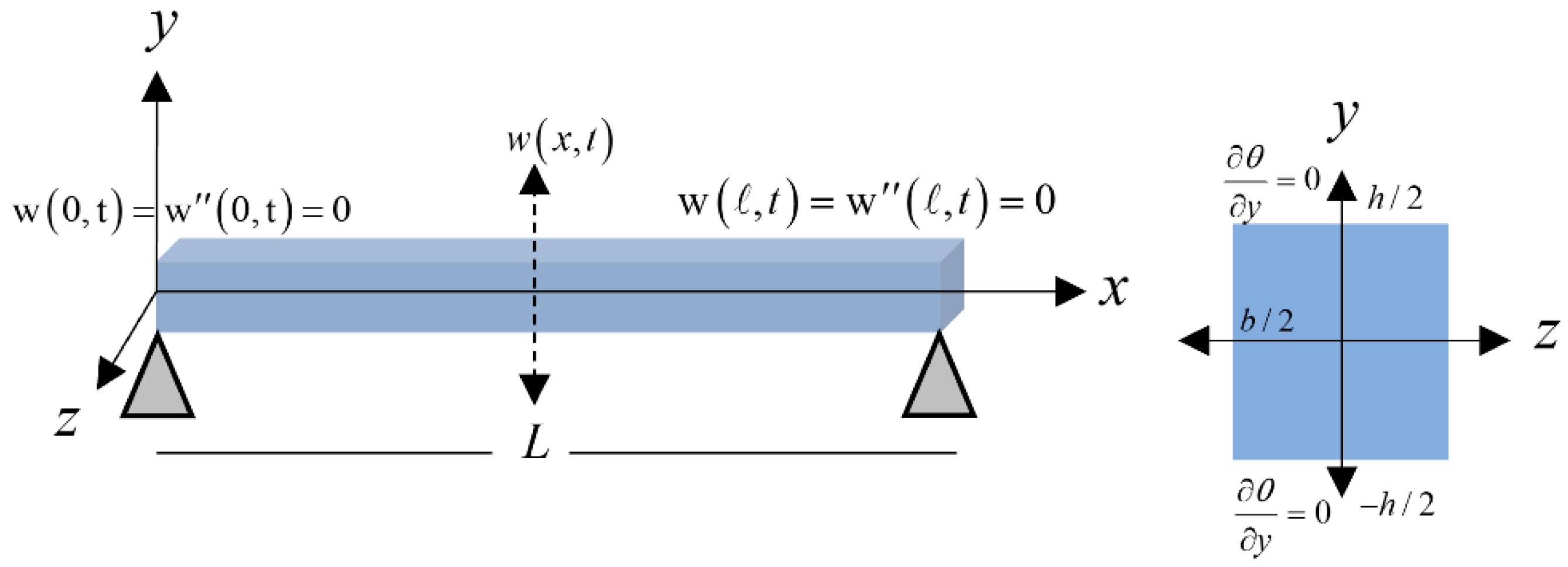

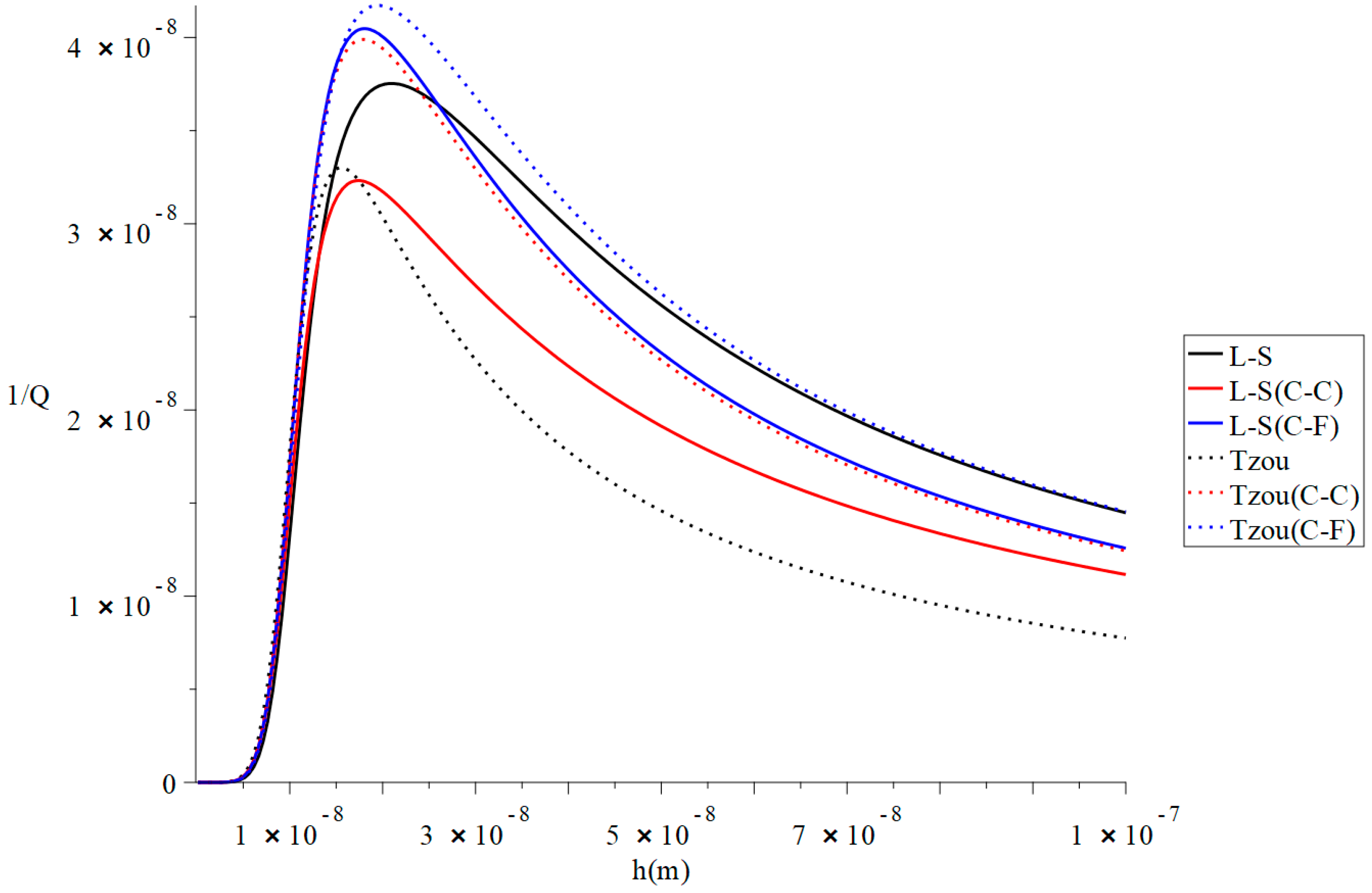
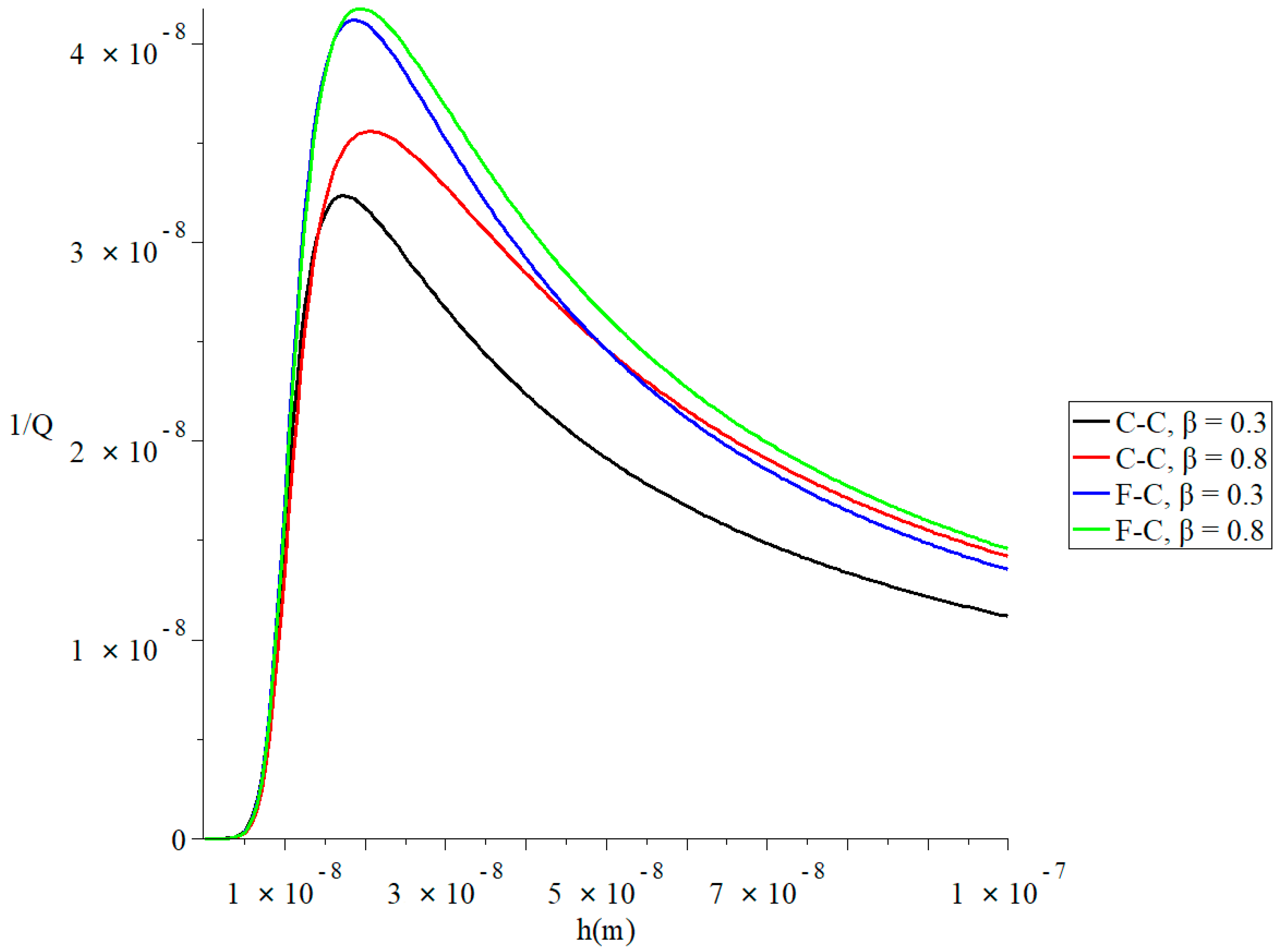

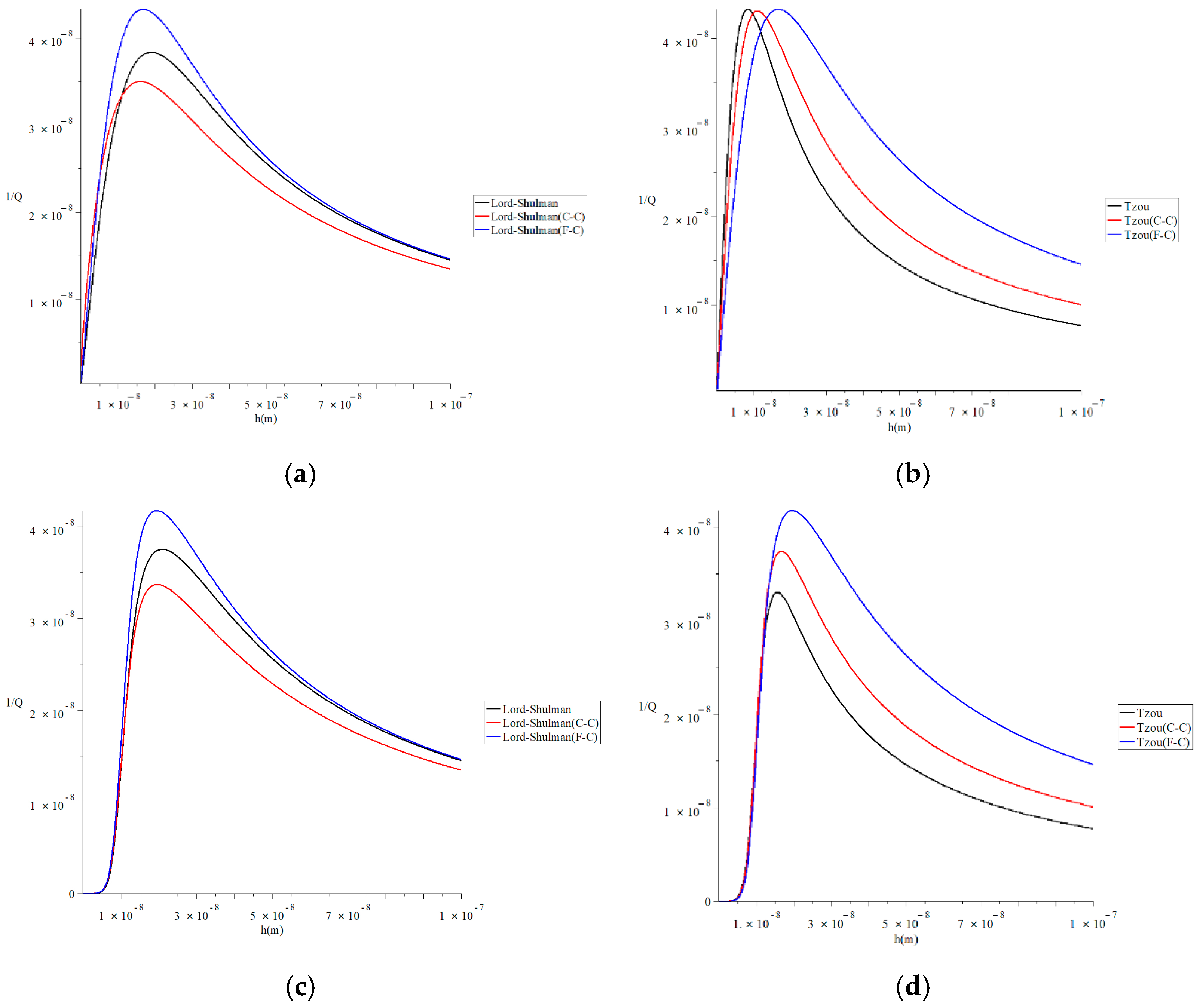
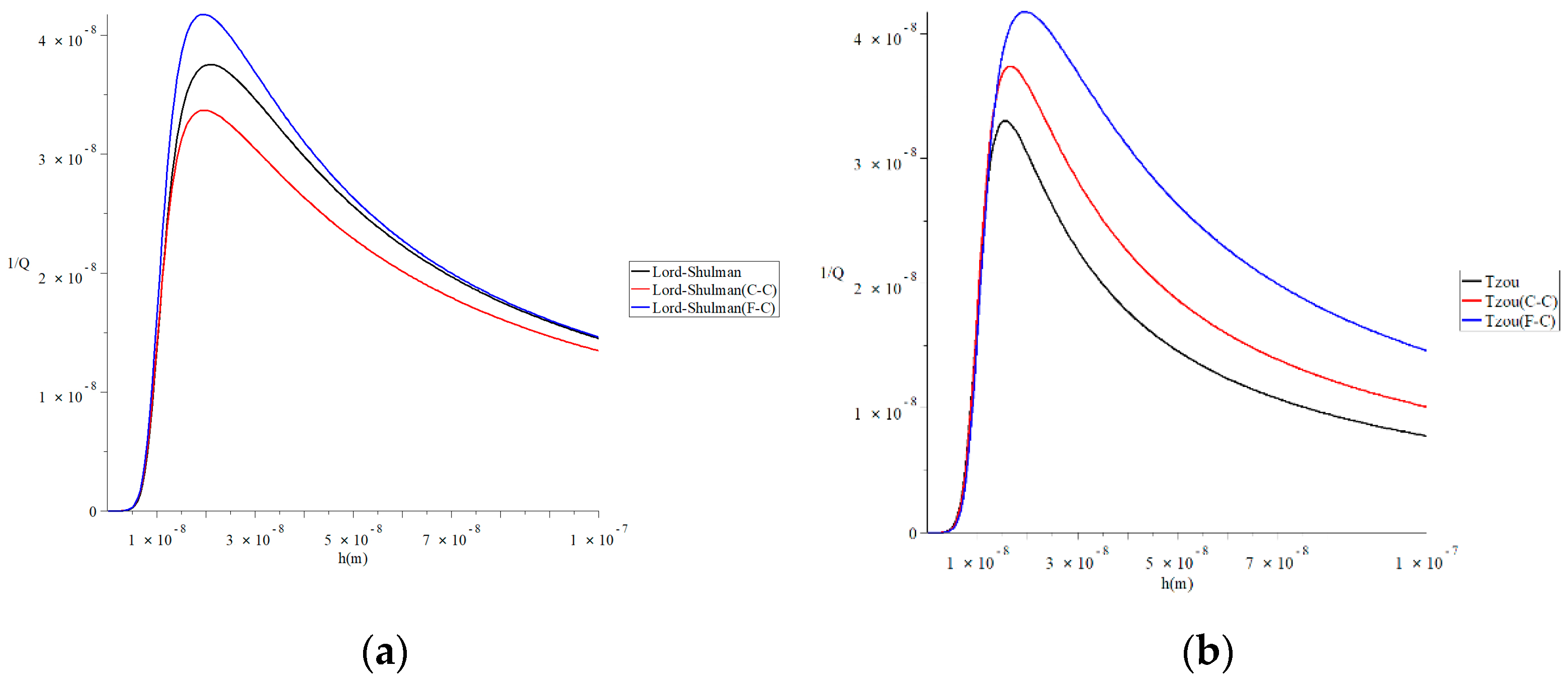
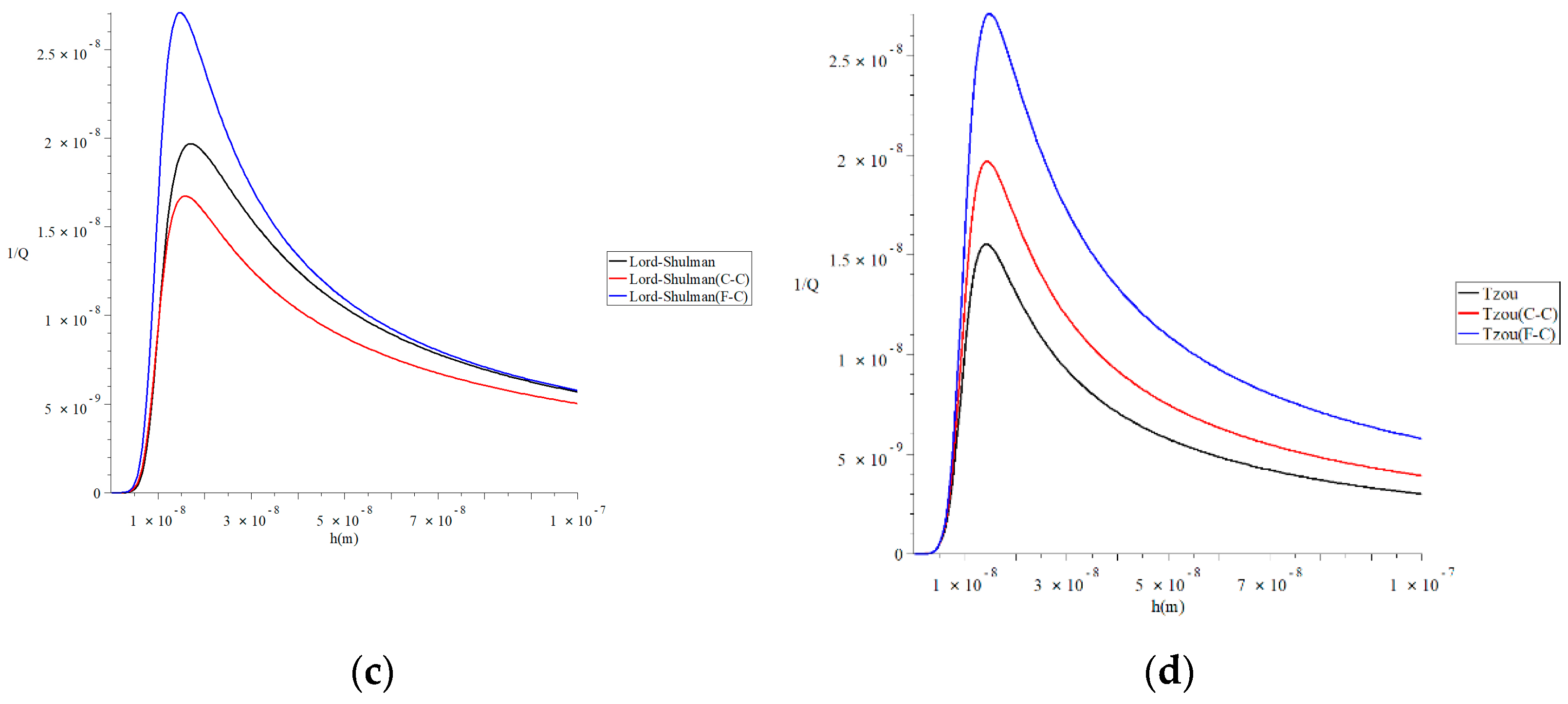

Publisher’s Note: MDPI stays neutral with regard to jurisdictional claims in published maps and institutional affiliations. |
© 2020 by the authors. Licensee MDPI, Basel, Switzerland. This article is an open access article distributed under the terms and conditions of the Creative Commons Attribution (CC BY) license (http://creativecommons.org/licenses/by/4.0/).
Share and Cite
Youssef, H.M.; El-Bary, A.A.; Al-Lehaibi, E.A.N. Characterization of the Quality Factor Due to the Static Prestress in Classical Caputo and Caputo–Fabrizio Fractional Thermoelastic Silicon Microbeam. Polymers 2021, 13, 27. https://doi.org/10.3390/polym13010027
Youssef HM, El-Bary AA, Al-Lehaibi EAN. Characterization of the Quality Factor Due to the Static Prestress in Classical Caputo and Caputo–Fabrizio Fractional Thermoelastic Silicon Microbeam. Polymers. 2021; 13(1):27. https://doi.org/10.3390/polym13010027
Chicago/Turabian StyleYoussef, Hamdy M., Alaa A. El-Bary, and Eman A. N. Al-Lehaibi. 2021. "Characterization of the Quality Factor Due to the Static Prestress in Classical Caputo and Caputo–Fabrizio Fractional Thermoelastic Silicon Microbeam" Polymers 13, no. 1: 27. https://doi.org/10.3390/polym13010027





